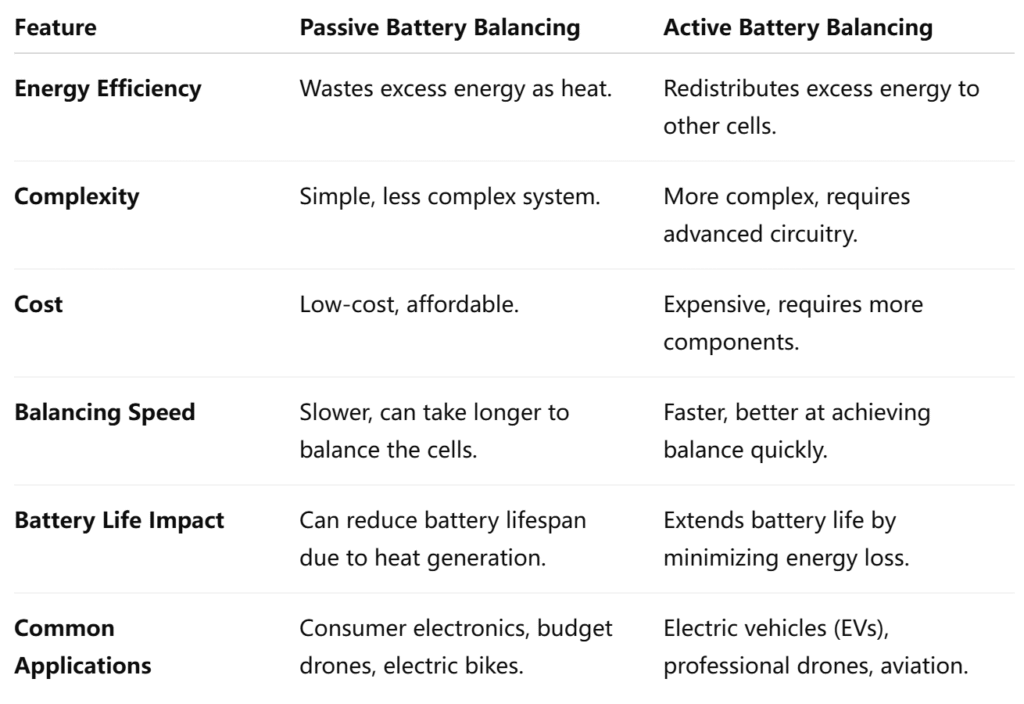The difference between Active Battery Balancing and Passive Battery Balancing technologies lies in the way they manage the charge distribution between individual cells in a battery pack. Both methods are used to improve battery performance and extend battery life, but they achieve this in very different ways. Let’s break down the key differences:
1. Passive Battery Balancing
How It Works:
- Passive balancing works by dissipating excess energy from the cells that have higher voltage (charge) through resistors. These resistors convert the excess voltage into heat.
- The process is relatively simple: when cells in the battery pack become imbalanced (i.e., some cells are charged higher than others), the system drains energy from the higher-charged cells until they match the lower-charged cells.
Advantages:
- Simplicity: Passive balancing systems are relatively simple to design and implement.
- Cost-Effective: These systems tend to be cheaper compared to active balancing solutions.
- Widely Used: It’s a widely used technology in most consumer-grade devices, like drones, electric bikes, and some electric vehicles.
Disadvantages:
- Energy Waste: The main drawback of passive balancing is that it wastes energy. The excess charge from higher-voltage cells is converted into heat, which results in a loss of energy efficiency.
- Limited Lifespan: Because of the heat generation, over time, this can reduce the lifespan of the battery pack.
- Slower Balance: Passive balancing may take longer to balance the battery pack because it relies on the dissipation of heat rather than redistributing charge.
Applications:
- Consumer Electronics: Common in devices like laptops, smartphones, and other small electronics.
- Electric Bikes & Scooters: Used in many low-cost electric vehicles and bikes.
- Budget Drones: Generally found in less expensive consumer drones.
2. Active Battery Balancing
How It Works:
- Active balancing works by redistributing excess charge from higher-voltage cells to the lower-voltage cells within the battery pack. It uses inductors, capacitors, or DC-DC converters to transfer energy from the high-energy cells to those that are undercharged.
- Rather than dissipating the excess energy as heat, active balancing ensures that the entire energy stored in the pack is used more efficiently.
Advantages:
- Energy Efficiency: Active balancing doesn’t waste energy. It redistributes the excess energy, making it far more energy-efficient than passive balancing.
- Longer Battery Life: By preventing the waste of energy and reducing unnecessary heating, active balancing can prolong the life of the battery pack.
- Faster Balancing: Active balancing can achieve a better balance much more quickly, as it continuously redistributes energy during charging and discharging.
Disadvantages:
- Complexity: Active balancing systems are more complex and require advanced circuitry.
- Higher Cost: The components used in active balancing (such as inductors and DC-DC converters) make these systems more expensive.
- Larger Size: Active balancing systems tend to be larger, which might make them less suitable for very small devices where space is limited.
Applications:
- High-End Electric Vehicles: Used in electric vehicles (EVs) and plug-in hybrid electric vehicles (PHEVs), where maximizing battery life and energy efficiency is critical.
- Electric Aircraft: Found in applications like electric aviation or drones that require highly efficient battery management.
- Advanced Drones: Professional-grade drones that demand high-performance, long-lasting batteries.
3. Key Differences at a Glance:

4. Conclusion:
In summary, active battery balancing is the more energy-efficient and longer-lasting technology compared to passive balancing, making it ideal for high-end applications like electric vehicles, professional drones, and electric aircraft. However, it comes at a higher cost and complexity. On the other hand, passive balancing is simpler and more affordable, making it suitable for low-cost, consumer-grade applications like smartphones, laptops, and budget drones.
When selecting a battery management system (BMS), consider the application, budget, and desired performance to choose the best balancing method.

